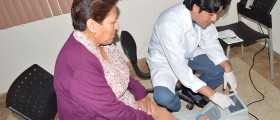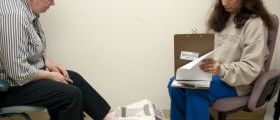
Osteopenia - Overview
Osteopenia is a medical condition which features with lower bone mineral density comparing to normal peak bone mineral density. Bone mineral density reflects the level of minerals in bones. In osteopenia bone mineral density is between 1.0 and 2.5. This condition is considered a precursor of much more serious condition called osteoporosis. However, not all the people suffering from osteopenia necessary develop osteoporosis.
The process of aging includes thinning of the bones. This process of bone thinning starts in the middle age and the bone cells are reabsorbed faster than the new bone cells are made. Consequently bones lose minerals, mass and their structure changes. All the previously mentioned makes the bone weaker and increases the risk of fractures.
Osteopenia may affect women at the onset of menopause. In this case osteopenia is caused by hormonal changes. Furthermore, there are several more factors which contribute to osteopenia. They include eating disorders, metabolic disorders, certain drugs such as chemotherapeutics and corticosteroids, radiation therapy, smoking, limited physical activity, chronic alcoholism etc. The condition may also occur in patients with family history of osteopenia.
Osteopenia is practically asymptomatic. People are simply not able to notice if their bones become thinner. The condition is diagnosed with a bone mineral density test and the dual- energy X-ray absorptiometry.
Treatment for Osteopenia
The goal of the treatment for osteopenia is to prevent progression of the disease and the onset of osteoporosis. Lifestyle changes may be rather effective in achieving the previously mentioned goals. Diet is, for example, essential for proper bone development. Optimal intake of calcium is vital since this is the most crucial mineral of the bones. Calcium can be found in many foods and if necessary it can be also taken in a form of supplements.
Furthermore, exercises are important part of prevention. They make the bone stronger and help the bone tissue to be more resistant to stress. The best exercises for osteopenia are weight-bearing exercises such as walking, hiking and dancing. The exercise program should be conceived by a well experienced physical therapist.
Medications are only given to patients with the highest risk of osteoporotic bone fracture. The treatment is generally given to postmenopausal women and men older than the age of 50. The treatment is also important for people with prior hip or vertebral fracture. Osteopenia is treated with bisphosphonates, selective estrogen receptor modulators and Teriparatide. Bisphosphonates can effectively prevent the loss of bone mass and selective oxygen receptor modulators selectively inhibit or stimulate estrogen-like action in many tissues.







-Test-And-What-Do-The-Results-Mean_f_280x120.jpg)









Your thoughts on this
Loading...